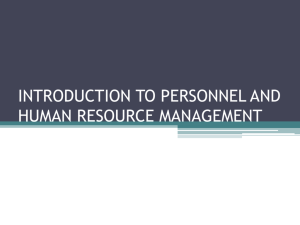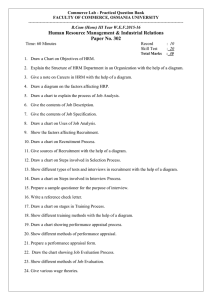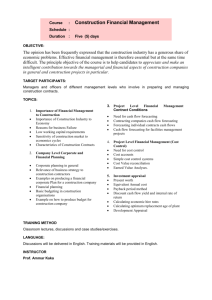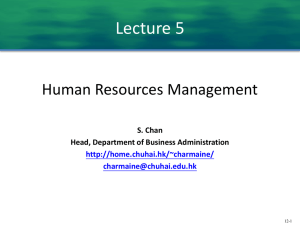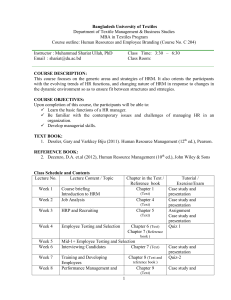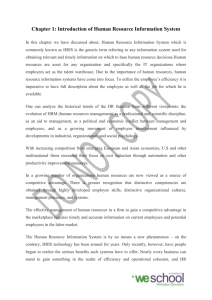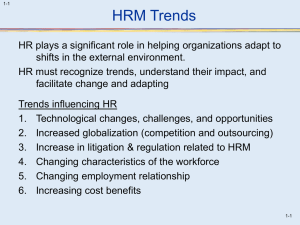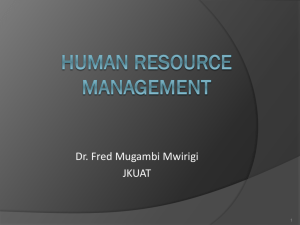Document
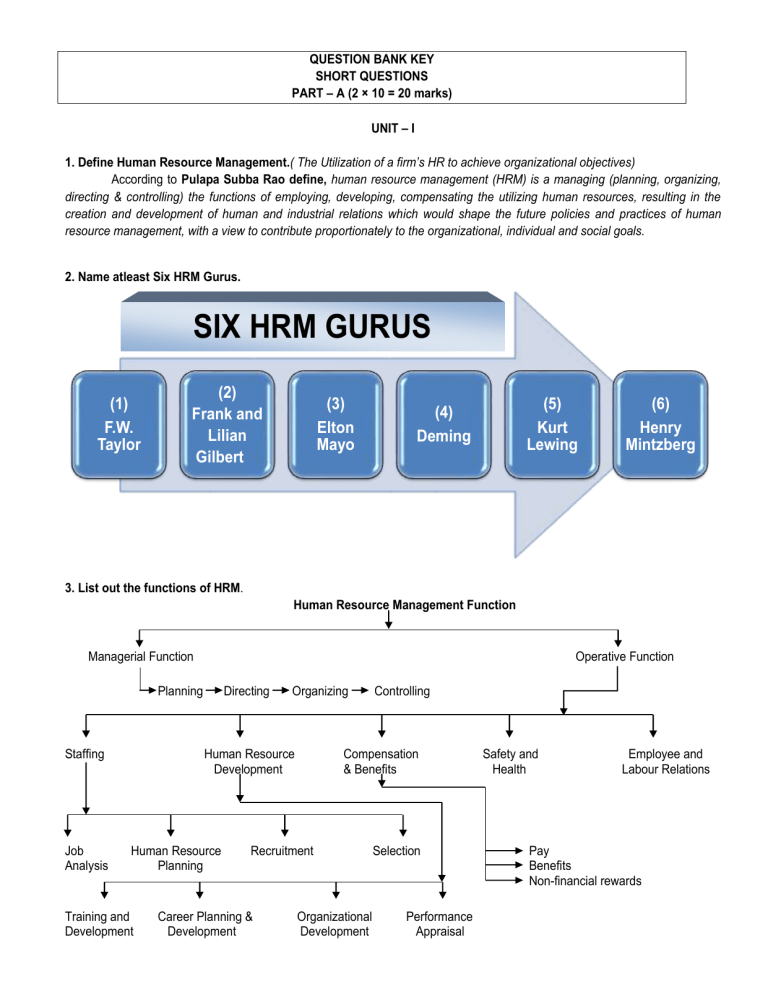
QUESTION BANK KEY
SHORT QUESTIONS
PART – A (2 × 10 = 20 marks)
UNIT – I
1. Define Human Resource Management.( The Utilization of a firm’s HR to achieve organizational objectives)
According to Pulapa Subba Rao define, human resource management (HRM) is a managing (planning, organizing, directing & controlling) the functions of employing, developing, compensating the utilizing human resources, resulting in the creation and development of human and industrial relations which would shape the future policies and practices of human
resource management, with a view to contribute proportionately to the organizational, individual and social goals.
2. Name atleast Six HRM Gurus.
SIX HRM GURUS
(1)
F.W.
Taylor
(2)
Frank and
Lilian
Gilbert
(3)
Elton
Mayo
(4)
Deming
(5)
Kurt
Lewing
(6)
Henry
Mintzberg
3. List out the functions of HRM.
Human Resource Management Function
Managerial Function
Planning Directing Organizing Controlling
Operative Function
Staffing Human Resource
Development
Compensation
& Benefits
Job Human Resource Recruitment Selection
Analysis Planning
Training and Career Planning &
Development Development
Organizational Performance
Development Appraisal
Safety and
Health
Employee and
Labour Relations
Pay
Benefits
Non-financial rewards
4. Mention the objectives of HRM.
Personal Objectives: To be ethically & socially responsible to the needs & challenges of the society while minimizing
the negative impact of such demand upon the organization.
Organizational Objectives: To recognize the role of HRM in bringing about organizational effectiveness.
Functional Objectives: To maintain the department’s contribution at a level appropriate to the organization’s needs.
Personal Objectives: To assist employees in achieving their personal goals, at least insofar as these goals enhance the individual’s contribution to the organization.
5. What is the role of HR manager?
The Conscience Role
The Counselor
The Mediator
The Spokesman
The Problem-solver
The Change Agent
6. Write the types of Human resource policies.
Originated policies
Appealed policies
Imposed policies
General policies
Specific policies
Written or implicit policies
7. Differentiate policies and procedures.
Sl. No.
1.
Policy
Policies are general instructions
Procedure
Procedures are specific policies
2.
8. Define HR policies.
Policies are guide to thinking Procedures are guides to action.
According to Brewster and Richbell defined HRM policies as, “a set of proposals and actions that act as a reference point for managers in their dealings with employees. HR policies constitute guides to action. They furnish the general standards or bases on which decisions are reached. Their genesis lies in an organization’s values, philosophy, concepts and principles”.
9. Define HRIS.
An HRIS may be defined as the system used to acquire, store, manipulate, analyze, retrieve, and distribute pertinent information regarding and organization’s human resource.
10. Write the application of HRIS.
Personnel administration
Salary administration
Skill inventory
Performance appraisal
11. What do you mean by HR Audit?
It is the analysis and evaluation of personnel policies, procedures, and practices to determine the effectiveness of human resource management in an organization.
12. Write the advantages of HRIS.
Reduced cost
Higher speed of data processing
Higher accuracy of information
Improved quality of reports.
13. What do you mean by HR Accounting?
Human Resource Accounting may also be defined as the measurement and reporting of the cost and value of people as organizational resources. It involves accounting for investment in people and their replacement costs, as well as accounting for the economic values of people to an organization.
14. Write the objectives of HRIS.
To acquire, store, manipulate, analyze, retrieve, and distributes the information of human resources.
To facilitate HR decision-making in the following areas: o Man-power planning o Recruitment & selection o Employment, including promotion, transfer, etc. o Education & training
To provide relevant information on employees to government agencies as part of the legal requirements.
15. Mention the scope of HRM.
Ensure acquisition, development, maintenance and control of human resources effectively.
UNIT II
1. Define Human Resource Planning.
According to Leon C. Megginson defines HRP is “an integrated approach to performing the planning aspects of the personnel function in order to have a sufficient supply of adequately developed and motivated people to perform the duties and
tasks required to meet organizational objectives and satisfy the individual needs and goals of organizational members.”
2. What do you mean by HR forecasting?
Human resource forecasting is the process by which an organization estimates it future human resource needs.
HR Forecasting = Forecasting HR Demands + Forecasting HR supplies
3. List some methods of forecasting.
Delphi technique
Work study technique
Ratio-trend analysis
Managerial judgment method
4. Write the objectives of HR planning
To recruit & retain the human resources of required quantity and quality.
To foresee the employee turnover and make the arrangements for minimizing turnover and filling up of consequent vacancies.
To foresee the impact of technology on work, existing employees & future human resource requirements. .
5. Define recruitment.
According to Edwin B. Flippo defined recruitment as “the process of searching for prospective employees and stimulating them to apply for jobs in the organization”
6. What is called selection?
According to P Subba Rao defines, after identifying the sources of human resources, searching for prospective employees and stimulating them to apply for jobs in an organization, the management has to perform the function of selecting the right employees at the right time. The obvious guiding policy in selection is the intention to choose the best qualified and suitable job candidate for each unfilled job.
.
7. List down various tests which are conducted during the selection process.
Psychological tests
Aptitude tests
Achievement tests
Situational tests
8. What do you mean by induction/ orientation?
Introducing the new employee who is designated as a probationer to the job, job location, surroundings, organization, organizational surroundings and various employees is the final step of employment process.
9. Write the objectives of medical examination?
To identify whether the candidate is physically fit to do the job.
It aims to prevent injury or damage to the health of the employees by placing them in proper job situations.
10. What do you mean by Interview?
An interview is a conversation or verbal interaction, normally between two people, for a particular purpose.
11. Write some socialization benefits.
It helps the new employee to understand their superiors.
It reduced employee dissatisfaction and reduces the proneness of grievances.
It develops a sense of belongingness and commitment.
12. Mention the sources of forecasting.
Job posting
Succession planning
Occupational market
Local labour market
13. List the various sources of recruitment.
Employee referrals
Head hunting
Campus recruitment
Outsourcing
14. What is meant by employee referrals?
This is a word of mouth technique in which present employees refer candidates from outside the organization.
15. What is meant by head hunting?
Top professional people are hunted through specialized agencies. The persons are approached personally with an offer to fill a vacancy.
UNIT III
1. What is meant by employee training? (Training refers to the process of imparting specific skills)
Training is the act of increasing the knowledge and skill of an employee for doing a particular job. Training is a short – term educational process and utilizing a systematic and organized procedure by which employees learn technical knowledge and skills for a definite purpose.
2. Write the benefits of training.
Increased productivity
Heightened morale
Reduced supervision.
3. Why employees resist training?
Employees feel it difficult to learn new concepts, skills, knowledge etc.,
It disturbs the employees from their routine duties.
4. What do you mean by TNA?
It is called as Training Need Analysis / Assessment.
5. What is called on-the-job training?
This type of training, also known as job instruction training, is the most commonly used method. Under this method, the individual is placed on a regular job and taught the skills necessary to perform that job. The trainee learns under the supervision and guidance of a qualified worker or instructor.
6. What is meant by off-the-job training? (Training offered at locations away from the job is designated as off-the-job training)
The trainee is separated from the job situation and his attention is focused upon learning the material related to his future job performance. Since the trainee is not distracted by job requirements, he can place his entire concentration on learning the job rather than spending his time in performing it.
7. What do you mean by executive/management development?
According to P. Subba Rao define, “Executive development is eventually something that the executive has to attain
himself. But he will do this much better if he is given encouragement, guidance and opportunity by his company”.
8. Write the objectives of EDP.
To overhaul the management machinery
To improve the performance of the managers
To increase morale of the members of the management group
To improve thought process and analytical ability.
To increase versatility of the management group
9. List various skills need in self development.
Human skill
Technical skill
Conceptual skill
10. Define knowledge management.
As Pattanayak points out, knowledge management is a major part of the strategy to use expertise to accomplish a sustainable competitive advantage in tomorrow’s business environment.
11. Write some of methods of EDP.
Job rotation
Incident method
Sensitivity training
Simulation
12. What is sensitivity training?
An organization development technique that is designed to help individuals learn how others perceive their behavior
(also known as T-group training).
13. What is role playing?
It is defined as a method of human interaction that involves realistic behaviour in imaginary situations. This method of training involves action, doing and practice. The participants play the role of certain characters such as the production manager, mechanical engineer, superintendents, maintenance engineers, quality control inspectors, foremen, workers and the like. This method is mostly used for developing inter-personal interactions and relations.
14. What do you mean by self-management?
Self management teaches people to observe their own behavior, compare their outputs to their goals and administer their own reinforcement to sustain goal commitment and performance.
15. Write the benefits of knowledge management.
Increased productivity
Improved quality of production
Improved work environment of an organization
Promotes innovation.
UNIT IV
1. Define compensation.
According to Indian Labour Organization (ILO) defined, “the remuneration paid by the employer for the services of
hourly, daily, weekly and fortnightly employees.” It also means that remuneration paid to production and maintenance or blue collar employees.
2. Write the objectives of compensation.
To acquire qualified competent personnel;
To retain the present employees;
To secure internal & external equality
To pay according to the content and difficulty;
To promote organization
3. Differentiate wage and salary.
Sl. No. Wage
1. It refers to an hourly rate or daily rate of pay.
Salary
Salary refers to a weekly, monthly or yearly rate of pay.
For white-collar workers 2. For blue-collar workers
4. What is called ESOP?
ESOP refers to Employee Stock Option Plan.
5. Mention the types of employee benefits.
Security benefits
Retirement benefits
Health care benefits
Time – off benefits
6. What do you mean by reward?
Reward can be anything that attracts the worker’s attention and stimulates him to work.
7. Write the types of reward.
Intrinsic and Extrinsic
Financial and non-financial
Performance-based and membership-based
8. Define career management.
The process of designing and implementing plans to enable the organization to satisfy employee needs and allow individuals to achieve their career goals.
9. What do you mean by career planning?
According to Edwin B. Flippo defined a career as, “a sequences of separate but related work activities that provides
continuity, order and meaning in a person’s life.”
10. Write about career development.
Career development can be defined as an “ongoing process by which individual progress through a series of stages,
each of which is characterized by a relatively unique set of issues, themes or tasks.”
11. Define motivation.
According to the Encyclopedia of Management, “motivation refers to the degree of readiness of an organization to pursue some designated goal and implies the determination of the nature and locus of the forces, including the degree of
readiness”.
12. Who is called as mentor and protégé?
A mentor is someone who offers informal career advice.
The mental and emotional support and guidance given usually by a senior employee to junior employee is called protégé.
13. Write the objectives of career management.
To attract and retain the right type of persons in organization.
Trained and developed for higher positions.
14. List down the advantages of mentoring.
It is the method of learning by doing.
Increased opportunities for high interaction and rapid feedback on performance.
15. Write the stages in career development.
Exploration (Transaction from school to work)
Establishment (Getting first job & being accepted)
Mid-Career (Will Performance increase or begin to decline)
Late-Career (The elder states person)
Decline (Preparing for retirement)
UNIT V
1. Define performance appraisal.
Performance appraisal is a method of evaluating the behaviour of employees in the work spot, normally including both the quantitative and qualitative aspects of job performance.
.
2. List down the performance appraisal methods.
Forced choice method
Graphic Rating Scales
Paired Comparison Method
Management by Objectives
Assessment Centers
Balance Scorecard
3. Write the purpose of performance appraisal.
To create and maintain a satisfactory level of performance.
To help the superiors to have a proper understanding about their subordinates.
To facilitate fair and equitable compensation based on performance
4. What do you mean by MBO?
Management by Objective (MBO) is a ‘process whereby the superior and subordinate managers of an organization jointly identify its common goals, define each individual’s major areas of responsibility in terms of results expected of him and use these measures of guides for operating the unit and assessing the contribution of its members.
5. What is meant by promotion?
According to Paul Pigors and Charles A. Myers defines, “Promotion is advancement of an employee to a better job –
better in terms of greater responsibility, more prestige or status, greater skill and especially increased rate of pay or salary.”
.
6. What is meant by demotion?
The remaining type of internal mobility is ‘demotion’. It is the opposite of promotion. Demotion is the reassignment of a lower level job to an employee with delegation of responsibilities and authority required to perform that lower level job and normally with lower level pay.
7. What is meant by transfer?
Transfer is defined as “a lateral shift causing movement of individuals from one position to another usually without
involving any marked change in duties, responsibilities, skills needed or compensation.”
8. What is meant by separation?
Separation means cessation of service with the organization for one or other reason.
9. What do you mean by controlling?
Controlling is the process by which management assures that actual activities conform to planned activities.
Controlling is the managerial process for measuring progress toward planned performance and, when required, taking corrective actions
10. Explain grievances.
According to Michael J. Jucions define Grievance as, “Any discontent of dissatisfaction whether exposed or not
whether valid or not arising out anything connected with the company which an employee thinks, believes or even feels to be unfair, unjust or inequitable”.
11. What do you mean by feedback?
Feedback is a discussion between the supervisor and the employee concerning the employee’s past performance and how that performance can be improved in the future.
12. Write the purpose of feedback.
Encourage present behavior
Explaining what is expected of employees
Planning for future performance improvement
Improving supervisor-subordinate relationships.
13. What is meant by 360 degree appraisal?
The appraiser may be any person who has through knowledge about the job content, contents to be appraised, standards of contents and who observes the employee while performing a job. He should prepare reports and make judgements without bias. Typical appraisers are: Supervisors, Peers, Subordinates, Employees themselves, Users of service and Consultants. Performance appraisal by all these parties is called 360 o Performance Appraisal.
14. What is called assessment centre?
An assessment centre is a procedure originally adopted to assess managerial potential. It consists of a standardized evaluation of behavior based on multiple raters and multiples measures.
15. Compare grievances with complaint.
A grievance is a specific, formal notice of employee dissatisfaction expressed through an identified procedure.
A complaint is merely an indication of employee dissatisfaction, which has not taken the formal grievance settlement route.
ESSAY TYPE QUESTIONS
UNIT I
1. Describe about the evolution of HRM.
Trade union era (2)
Social responsibility era (2)
Scientific management era (2)
Human relations era (2)
Behavioral science era (3)
Systems approach era (2)
Contingency approach era (3)
2. Explain the objectives and functions of HRM.
Objectives (4)
Societal objectives
Organizational objectives
Functional objectives
Personal objectives
Functions (12)
Human Resource Management Function
Managerial Function
Planning Directing Organizing Controlling
Operative Function
Staffing Human Resource
Development
Compensation
& Benefits
Job Human Resource Recruitment Selection
Analysis Planning
Safety and
Health
Employee and
Labour Relations
Pay
Benefits
Non-financial rewards
Training and Career Planning &
Development Development
Organizational Performance
Development Appraisal
3. Enumerate the roles and responsibilities of HR Manager in an organization.
Roles (8)
Personnel role
Welfare role
Clerical role
Fire-fighting role
Responsibilities (8)
As a HR specialist
As a operating manager
4. What do you mean by Human Resource Policies? Explain it.
Definition (2)
A policy is a guideline for a wide variety of employment relationships in the organizations.
Types (12)
Originated policy
Appealed policy
Imposed policy
General policy
Specific policy
Written or implicit policy
Scope (2)
Employment
Training and development
Transfers and promotions
Compensation
Working conditions
Employee service and welfare
Industrial relations
5. Describe the importance and application of HRIS in any organization.
Definition (2)
HRIS is a systematic way of storing data and information for each individual employee to aid planning, decision making and submitting of returns and reports to the external agencies.
Areas of Applications (10)
Personnel administration
Salary administration
Leave/absence recording
Skill inventory
Medical history
Accident monitoring
Performance appraisal
Training and development
Manpower planning
Recruitment
Career planning
Collective bargaining
Benefits (4)
Higher speed of data processing
Reduced cost
Reclassifying data
Higher accuracy of information
UNIT II
1. Explain the concept of HR planning and its process.
Definition (2)
A process of determining and assuming that the organization will have an adequate number of qualified persons, available at the proper times, performing jobs which meet the needs of the enterprise and which provide satisfaction for the individuals involved.
Objectives (4)
To ensure optimum use of existing HR.
To forecast future requirements
To provide control measures
To assess the surplus and shortage of HR.
Process (10)
Collect information
Forecast demand for human resources
Forecast supply of human resources
Identify human resources gap
Action plans.
2. Write detailed notes on sources and methods of HR forecasting.
Meaning (2)
Forecasting is the process of estimating the future quantity and quality of people required.
Methods (7)
Demand forecasting
Managerial judgment method
Delphi technique
Work-study technique
Ratio-trend analysis
Statistical and mathematical models
Supply forecasting
Head count
Job family inventory
Skill inventory
Sources (7)
Job posting
Hiring employees
Succession planning
Occupational market
Local labour ,market
General economic conditions
3. Describe about recruitment and its sources.
Definition (2)
A process to discover the sources of manpower to meet the requirements of staffing scheduling and to employ effective measures for attracting the manpower in adequate numbers to facilitate effective.
Sources (7)
Campus interview
Professional association
‘walk-in
Head hunting
Body shopping
Outsourcing
Process (7)
Determine the exact need
Obtain approval
Update job description
Choose recruitment sources
Screen responses
5. Illustrate the various steps in selection process.
Definition (2)
The process by which the organization chooses from among the applicants, those people whom they feel would best meet the job requirement, considering current environmental conditions.
Steps (14)
6. Explain about socialization and its benefits.
Definition (2)
HRM activity that introduces new employees to the organization and to the employee’s new tasks, managers, and workgroups.
Purpose (14)
To create a favorable impression
To reduce anxiety and hazing
To develop realistic job expectations
To reduce start-up costs
To save time
To improve new worker productivity
To reduce turnover
To reduce conflict
To strengthen organizational culture
UNIT III
1. Explain about various methods of training in detail.
Definition(2)
Training is the act of increasing the knowledge and skill of an employee for doing a particular job.
Methods
2. Describe the needs, resistance and importance of training.
Needs (8)
Technical advances
Reduced accidents
Increased organizational stability
To match the employee specifications
Resistance (8)
Employee feel it difficult to learn new concepts
Expected to learn more difficult activities
Lose their job authority
Disturb the routine duties
3. Explain about Executive Development programme.
Definition (2)
The process by which managers and executives acquire not only skills and competency in their present jobs but also capabilities for future managerial tasks of increasing difficulty and scope.
Common practices (6)
In-company programme
Prog. By mgt. associations
University prog.
Methods (8)
On-the job
Off-the job
4. Elaborate the concept of self development. (16)
Technical skill
Human skill
Conceptual skill
5. Enumerate the various steps in knowledge management process.
Definition (2)
It is the capacity to act.
Stages (14)
Identify stage
Collect stage
Select stage
Store stage
Share stage
Apply stage
Customer acceptance
Create stage
UNIT IV
1. Describe various forms of compensation system. (16)
2. Explain about rewards and benefits with suitable examples.
Definition (2)
Reward can be anything that attracts the worker’s attention and stimulates him to work.
Pay
Incentives
Benefit
Types (14)
Intrinsic and Extrinsic
Financial and non-financial
Performance-based and membership-based
3. What is called motivation? Explain it with their theories.
Definition (2)
A process of stimulating people to action to accomplish desired goods.
Types (4)
Positive
Negative
Theories (10)
Maslow’s Hierarchy of Needs.
Herzberg’s Two – factor Theory.
Vroom’s Expectancy Theory.
Alderfer’s ERG Theory.
Porter and Lawler’s Expectancy Theory.
Equity Theory of Work Motivation.
4. Describe the career development stages in detail.
Definition (2)
The process of designing and implementing plans to enable the organization to satisfy employee needs and allow individuals to achieve their career goals.
Stage (14)
5. Explain the stages in mentor-protégé relationship.
Definition (4)
A mentor is someone who offers informal career advice.
The mental and emotional support and guidance given usually by a senior employee to junior employee is called protégé.
Stages (8)
Initiation
Cultivation
Separation
Redefinition
Advantages (4) it is the method of learning by doing.
Increased opportunities for high interaction and rapid feedback on performance.
UNIT V
1. Describe about performance appraisal and its methods in detail.
Definition (2)
It is the systematic, periodic and an impartial rating of an employee’s job related attributes, behaviours and outcomes.
Methods (14)
2. Write a detailed note on promotion, demotion, transfer and separation.
Promotion (4)
A promotion is a reassignment of the individual to a job of higher rank.
Demotion (4)
A demotion is the reassignment of an employee to a job of lower status and pay.
Transfer (4)
A transfer consists of a reassignment of an employee to another job of similar pay, status, and responsibility.
Separation (4)
Separation means cessation of service with the organization for one or other reason.
3. Explain about the concept of control process.
Definition (2)
Controlling is the process by which management assures that actual activities conform to planned activities.
Importance (6)
Adapting to changing
Minimizing mistakes and errors
Minimizing costs
Coping with organizational complexity
Process (8)
Establishing standards
Measuring performance
Comparing measured performance against standards
Evaluate performance and take action
4. Enumerate the grievance - redressal procedure in detail.
GRIEVANCES (2)
A grievances is a specific, formal notice of employee dissatisfaction expressed through an identified procedure.
CAUSES (3)
Grievances arising out of working conditions.
Grievances arising from management policy.
Grievances arising from alleged violation.
Grievances arising out of personal mal-adjustment.
FORMS OF GRIEVANCES (2)
Factual
Imaginary
Disguised
Implications of grievances (3)
Low quality of production and profit.
Increase in wastage of material etc.,
Increase in rate of absenteeism and turnover.
Reduces the level of commitment, sincerity and punctuality.
Increase the incidence of accidents.
Reduces the level of employee morale.
Strains the superior-subordinate relations.
Increase in indiscipline cases.
REDRESSAL METHODS (6)
Grievance is a formal channel of communication designed to resolve formal complaints. It is termed as redressal.
5. Explain the importance and nature of feedback system in an organization.
Definition (2)
It is a Feedback is a discussion between the supervisor and the employee concerning the employee’s past performance and how that performance can be improved in the future.
Purpose (8)
Encourage present behavior
Explaining what is expected of employees
Planning for future performance improvement
Improving supervisor-subordinate relationships.
Types (6)
Tell and sell
Tell and listen
Problem-solving approach
